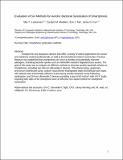| dc.contributor.author | Lieberman, Mia | |
| dc.contributor.author | Madden, Carolyn | |
| dc.contributor.author | Ma, Eric Jinglong | |
| dc.contributor.author | Fox, James G | |
| dc.date.accessioned | 2019-10-21T15:23:27Z | |
| dc.date.available | 2019-10-21T15:23:27Z | |
| dc.date.issued | 2018-01 | |
| dc.identifier.issn | 1559-6109 | |
| dc.identifier.uri | https://hdl.handle.net/1721.1/122643 | |
| dc.description.abstract | Smartphones are ubiquitous devices that offer a variety of useful applications for human and veterinary medical professionals and the biomedical research community. Smartphones can serve as fomites and potentially transmit pathogens, including bacterial species such as methicillin-resistant Staphylococcus aureus. The goal of this study was to evaluate 6 methods to decrease aerobic bacterial colonies on smartphones, including two 254-nm UVC devices, 70% ethanol spray, quaternary ammonium disinfectant spray, sodium hypochlorite-impregnated wipes, and delicate-task wipes. All methods were individually effective at decreasing aerobic bacterial counts after sanitization. In addition, 254-nm UVC devices providing a dose of 60 mJ/cm², with UVC bulbs exposing both sides of the smartphone, were an effective nonliquid method for smartphone sanitization. | en_US |
| dc.description.sponsorship | National Institutes of Health (U.S.) (Grant T32-OD010978) | en_US |
| dc.description.sponsorship | National Institutes of Health (U.S.) (Grant P30-ES002109) | en_US |
| dc.language.iso | en | |
| dc.publisher | American Association for Laboratory Animal Science (AALAS) | en_US |
| dc.relation.isversionof | https://www.ingentaconnect.com/content/aalas/jaalas/2018/00000057/00000001/art00004# | en_US |
| dc.rights | Creative Commons Attribution-Noncommercial-Share Alike | en_US |
| dc.rights.uri | http://creativecommons.org/licenses/by-nc-sa/4.0/ | en_US |
| dc.source | 421331 | en_US |
| dc.title | Evaluation of 6 Methods for Aerobic Bacterial Sanitization of Smartphones | en_US |
| dc.type | Article | en_US |
| dc.identifier.citation | Lieberman, Mia T. et al. "Evaluation of 6 Methods for Aerobic Bacterial Sanitization of Smartphones." Journal of the American Association for Laboratory Animal Science 57, 1 (January 2018): 24-29 © 2018 American Association for Laboratory Animal Science (AALAS) | en_US |
| dc.contributor.department | Massachusetts Institute of Technology. Division of Comparative Medicine | en_US |
| dc.contributor.department | Massachusetts Institute of Technology. Department of Biological Engineering | en_US |
| dc.relation.journal | Journal of the American Association for Laboratory Animal Science | en_US |
| dc.eprint.version | Author's final manuscript | en_US |
| dc.type.uri | http://purl.org/eprint/type/JournalArticle | en_US |
| eprint.status | http://purl.org/eprint/status/PeerReviewed | en_US |
| dc.date.updated | 2019-10-17T13:38:37Z | |
| dspace.date.submission | 2019-10-17T13:38:40Z | |
| mit.journal.volume | 57 | en_US |
| mit.journal.issue | 1 | en_US |
